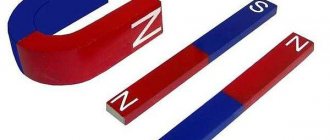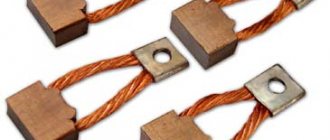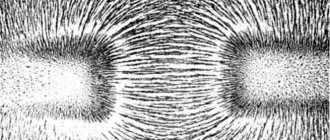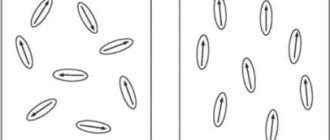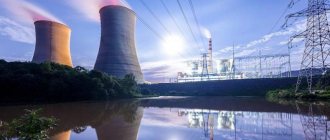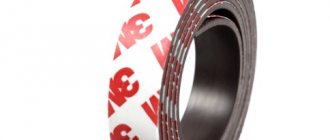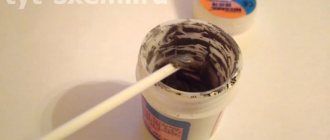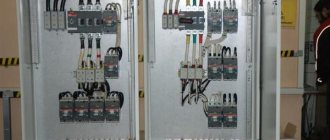A Neodymium magnet
(also known as
NdFeB
,
NIB
, or
Neo
magnet) is the most widely used[1] type of rare earth magnet. It is a permanent magnet made from an alloy of neodymium, iron, and boron to form a Nd2Fe14B quadrangular crystal structure.[2] Independently developed in 1984 by General Motors and Sumitomo Special Metals,[3][4][5] neodymium magnets are the most powerful permanent magnets available on the market.[2][6] Due to different manufacturing processes, they are divided into two subcategories: sintered NdFeB magnets and bonded NdFeB magnets.[7][8] They have replaced other types of magnets in many applications in modern products requiring strong permanent magnets, such as electric motors in cordless tools, hard drives, and magnetic fasteners.
Story
General Motors (GM) and Sumitomo Special Metals independently discovered Nd2Fe14B almost simultaneously in 1984.[3] The research was initially prompted by the high cost of raw materials. SmCo permanent magnets which were developed earlier. GM focused on developing melt-spun nanocrystalline neodymium 2Fe14B, while Sumitomo developed sintered Nd2Fe14B magnets. GM commercialized its inventions isotropic neo powder, bonded neo magnets, and related manufacturing processes, founding Magnequench in 1986 (Magnequench has since become part of Neo Materials Technology, Inc., which later merged with Molicorp). The company supplied melt-formed neodymium 2Fe14 Powder B to magnet manufacturers. The Sumitomo facility became part of Hitachi Corporation, and produced but also licensed to other companies the production of sintered neodymium 2Fe14 magnets. Hitachi holds over 600 patents for neodymium magnets.[9]
Chinese manufacturers have become the dominant force in neodymium magnet production due to their control of much of the world's rare earth supply.[10]
The US Department of Energy identified the need to find substitutes for rare earth metals in permanent magnet technology and funded such research. The Advanced Research Projects Agency - Energy sponsored the Rare Earth Alternatives in Critical Technologies (REACT) program to develop alternative materials. In 2011, ARPA-E awarded $31.6 million to fund rare earth replacement projects.[11] Because of its role in permanent magnets used for wind turbines, it has been argued that neodymium will become one of the major targets of geopolitical competition in the world's renewable energy sector. But this view has been criticized for not recognizing that most wind turbines do not use permanent magnets and for underestimating the power of economic incentives to expand production.[12]
Composition
Neodymium is a metal that is ferromagnetic (more specifically it shows antiferromagnetic properties), that is, like iron, it can be magnetized to become a magnet, but its Curie temperature (the temperature above which its ferromagnetism disappears) is 19 K (-254. 2 °C; -425.5 °F), so in its pure form its magnetism only appears at extremely low temperatures.[13] However, compounds of neodymium with transition metals such as iron can have a Curie temperature much higher than room temperature, and they are used to make neodymium magnets.
The strength of neodymium magnets is the result of several factors. Most importantly, the tetragonal Nd2Fe14 crystal structure B has exceptionally high uniaxial magnetocrystalline anisotropy ( HR
A ≈ 7 - magnetic field strength H in units of A / m depending on the magnetic moment in A m2).[14][3] This means that a crystal material is preferentially magnetized along a certain crystal axis but is very difficult to magnetize in other directions. Like other magnets, a neodymium alloy magnet is composed of microcrystalline grains that are aligned in a powerful magnetic field during manufacturing so that all of their magnetic axes point in the same direction. The resistance of the crystal lattice to change the direction of magnetization gives the connection a very high force, or resistance to demagnetization.
A neodymium atom can have a large magnetic dipole moment because it has 4 unpaired electrons in its electronic structure[15] as opposed to (on average) 3 in iron. In a magnet, it is the unpaired electrons, aligned so that their spins are in the same direction, that create the magnetic field. This gives the Nd2Fe14B compound a high saturation magnetization ( J
s ≈ 1.6 or 16 ) and residual magnetization is usually 1.3 tesla.
Therefore, since the maximum energy density is proportional to J
s2, this magnetic phase has the potential to store large amounts of magnetic energy (
BH
Maximum ≈ 512 kJ/m3 or 64 MG Oe). This magnetic energy value is approximately 18 times greater than that of “ordinary” ferrite magnets by volume and 12 times by mass. This magnetic energy property is higher in NdFeB alloys than in alloys. samarium cobalt (SmCo) magnets, which were the first type of rare earth magnets to be commercialized. In practice, the magnetic properties of neodymium magnets depend on the alloy composition, microstructure and manufacturing technology.
Nd2Fe14The crystal structure of B can be described as alternating layers of iron atoms and neodymium-boron compounds.[3] In diamagnetic, boron atoms do not directly contribute to magnetism, but improve cohesion through strong covalent bonding.[3] The relatively low content of rare earth elements (12% by volume) and the relative content of neodymium and iron compared to samarium and cobalt make neodymium magnets cheaper than samarium-cobalt magnets.[3]
What alloy is used in the product
Our store presents products with an average neodymium content. We mainly offer to buy N42 neodymium magnets. In the catalog you will find rings, disks, rods, bars and other forms of devices, as well as vinyl blanks and puzzles. Products are divided into categories by weight and, accordingly, by price. If you need serious power of the product, we suggest purchasing products with a more impressive weight. If there is no need for serious pull-off force, you can buy a neodymium magnet N42 of small dimensions. Please note that most of the products on the site are made in Russia and fully comply with the declared properties. The company's consultants are always ready to help with the choice.
Characteristics
Neodymium magnets (small cylinders) lift the steel spheres. Such magnets can easily lift thousands of times their own weight. Ferrofluid on a glass plate shows the strong magnetic field of a neodymium magnet below.
Ratings
Neodymium magnets are classified by their maximum energy product, which refers to the magnetic flux output per unit volume. Higher values indicate stronger magnets. There is a widely accepted international classification for sintered NdFeB magnets. Their values range from 28 to 52. The first letter N before the values is short for neodymium, which stands for NdFeB sintered magnets. The letters following the values indicate the internal coercivity and maximum operating temperatures (positively correlated with Curie temperature), which range from default values (up to 80 °C or 176 °F) to AH (230 °C or 446 °F) .[16][17]
Brands of sintered NdFeB magnets:[7][ further explanation required
][18][
unreliable source?
]
- N30 - N52
- Н30М - Н50М
- N30H - N50H
- N30SH - N48SH
- N30UH - N42UH
- N28EH - N40EH
- N28AH - N35AH
Magnetic properties
Some important properties used to compare permanent magnets are:
- Acuity (
Bp )
, which measures the strength of the magnetic field. - Coercivity (
HR ci)
, the resistance of a material to demagnetization. - (Maximum) Energy product (
BH Maximum)
, magnetic energy density, [19] is characterized by a maximum value of magnetic flux density (B) times magnetic field strength (HOUR). - Curie temperature (
TC )
, the temperature at which a material loses its magnetism.
Neodymium magnets have a higher remanence, much higher coercivity and energy product, but often a lower Curie temperature than other types of magnets. Special neodymium magnetic alloys that include terbium and dysprosium have been developed that have a higher Curie temperature, allowing them to withstand higher temperatures.[20] The table below compares the magnetic characteristics of neodymium magnets with other types of permanent magnets.
| Magnet | B r (T) | HOUR ci (kA/m) | BH Maximum (kJ/m3) | T C | |
| (°C) | (°F) | ||||
| Nd2Fe14B, sintered | 1.0–1.4 | 750–2000 | 200–440 | 310–400 | 590–752 |
| Nd2Fe14B, glued | 0.6–0.7 | 600–1200 | 60–100 | 310–400 | 590–752 |
| SmCo5, sintered | 0.8–1.1 | 600–2000 | 120–200 | 720 | 1328 |
| Sm (Co, Fe, Cu, Zr)7, sintered | 0.9–1.15 | 450–1300 | 150–240 | 800 | 1472 |
| Alnico, sintered | 0.6–1.4 | 275 | 10–88 | 700–860 | 1292–1580 |
| Sr-ferrite, sintered | 0.2–0.78 | 100–300 | 10–40 | 450 | 842 |
Physical and mechanical properties
Micrograph of NdFeB showing magnetic domain boundary Comparison of physical properties of sintered neodymium and Sm-Co magnets[21][22]
| Property | Neodymium | Sm-Co |
| Acuity() | 1–1.5 | 0.8–1.16 |
| Coercivity (MA/m) | 0.875–2.79 | 0.493–2.79 |
| Relative permeability | 1.05 | 1.05–1.1 |
| Temperature coefficient of remanent magnetization (%/K) | −(0.12–0.09) | −(0.05–0.03) |
| Temperature Coercivity Coefficient (%/K) | −(0.65–0.40) | −(0.30–0.15) |
| Curie temperature (°C) | 310–370 | 700–850 |
| Density (g/cm3) | 7.3–7.7 | 8.2–8.5 |
| Coefficient of thermal expansion, parallel to magnetization (1/K) | (3–4)×10−6 | (5–9)×10−6 |
| Coefficient of thermal expansion, perpendicular to magnetization (1/K) | (1–3)×10−6 | (10–13)×10−6 |
| Bending Strength (N/mm2) | 200–400 | 150–180 |
| Compressive Strength (N/mm2) | 1000–1100 | 800–1000 |
| Tensile strength (N/mm2) | 80–90 | 35–40 |
| Vickers hardness (VH) | 500–650 | 400–650 |
| Electrical resistivity (Ohm cm) | (110–170)×10−6 | (50–90)×10−6 |
Corrosion problems
These neodymium magnets were severely corroded after five months of weather conditions.
Sintered Nd2Fe14B is generally vulnerable to corrosion, especially along the grain boundaries of the sintered magnet. This type of corrosion can cause severe damage, including turning the magnet into a powder of fine magnetic particles or chipping the surface layer.
This vulnerability is addressed in many commercial products by adding a protective coating to prevent exposure to the atmosphere. Nickel plating or two-layer copper-nickel plating are standard methods, although plating with other metals or polymer and varnish protective coatings are also used.[23]
Temperature effects
Neodymium has a negative coefficient meaning coercive force along with magnetic energy density ( BH
Maximum) decreases with temperature. Neodymium, iron, and boron magnets have high coercive force at room temperature, but as the temperature increases above 100 °C (212 °F), the coercive force decreases sharply to the Curie temperature (about 320 °C or 608 °F). This drop in coercivity limits the efficiency of the magnet in high temperature environments such as wind turbines, hybrid engines, etc. Dysprosium (Dy) or terbium (Tb) is added to limit the drop in performance due to temperature changes, making the magnet even more dear.[24]
Decrease in magnetic energy over time
As you know, neodymium magnets lose their properties slightly over time, about 1-2% every decade. At the same time, engineers should take into account demagnetization when creating certain devices. Thus, after 20 years of operation in a generator, a neodymium magnet N50 will be able to perform its functions by 86-98%. Of course, in everyday life such a difference is almost unnoticeable, but in the case of precision equipment, it may be necessary to replace the neodymium part. Note that the ferrimagnetic alloy will lose an incomparably large part of its properties during this time.
Dangers
The high forces exerted by rare earth magnets create hazards that may not occur with other types of magnets. Neodymium magnets larger than a few cubic centimeters are strong enough to cause injury to body parts sandwiched between two magnets or a magnet and a ferrous metal surface, and even cause bone fractures.[25]
Magnets that get too close to each other can hit each other with enough force to break and shatter the fragile magnets, and flying chips can cause a variety of injuries, especially eye injuries. There have even been cases where small children who have swallowed multiple magnets have had areas of their digestive tract pinched between the two magnets, which can result in injury or death. It can also be a serious health risk when working with machines that have or are attached to magnets. [26] Stronger magnetic fields can be dangerous to mechanical and electronic devices, as they can erase magnetic media such as floppy disks and credit cards, and magnetize watches and shadow masks from CRT-type monitors at a greater distance than other types of magnet. In some cases, chipped magnets can cause fires as they come together, sending sparks flying as if they were a lighter. flint because some neodymium magnets contain ferrocerium.
Weight of magnetic devices
However, when selecting a rod, ring or bar made of neodymium, one should not forget that the tearing force they possess depends not only on the properties of the metal, but also on the massiveness of the product itself. Small and large devices have different attractive characteristics, even if their composition is absolutely identical. Thus, an N35 neodymium magnet in the form of a 70x50 disk will certainly be more powerful and, accordingly, more efficient than a 40x10 cylinder, albeit made from a class 52 alloy. Although, it is possible to accurately determine the characteristics of a particular product only with the help of special measuring instruments.
Traditionally, online stores sell products made from materials with a relatively low energy level, most often neodymium magnets N35-42. And if the client wants to purchase a more powerful device, he simply chooses a product of greater weight and the desired shape. More impressive indicators are found in neodymium parts produced for special complex devices, for example, for particle accelerators, aircraft, or space modules. In such devices, it is necessary to achieve maximum efficiency with the smallest dimensions and weight; accordingly, an N38 neodymium magnet is not suitable here. Indeed, in the case of delivery into orbit, every kilogram of cargo and every extra cubic centimeter of free space is important.
Production
There are two main methods for producing neodymium magnets:
- Classical powder metallurgy or sintered magnet process[27] Sintered neodymium magnets are produced by melting raw materials in a furnace, pouring into a mold, and cooling to form ingots. The ingots are crushed and ground; the powder is then sintered into dense blocks. The blocks are then heat treated, cut to shape, surface treated and magnetized.
- Bonded neodymium magnets are made by melt spinning thin strip of NdFeB alloy. The tape contains randomly oriented Nd2Fe14B nanosized grains. This tape is then crushed into particles, mixed with polymer, and either compressed or injection molded into bonded magnets.
In 2015, Nitto Denko Corporation of Japan announced the development of a new method for sintering neodymium magnetic material. This method uses "organic/inorganic hybrid technology" to form a clay-like mixture that can be formed into various shapes for sintering. Most importantly, it is possible to control the non-uniform orientation of the magnetic field in the sintered material to locally concentrate the field, for example to improve the performance of electric motors. Serial production is planned for 2022.[28][29]
As of 2012, 50,000 tons of neodymium magnets are officially produced each year in China, and 80,000 tons by company-by-company ramp-up in 2013.[30] China produces more than 95% of rare earth elements and produces about 76% of all rare earth magnets in the world, as well as most of the world's neodymium.[31][9]
Application of neodymium magnets
Neodymium magnets are widely used in various fields of human activity. Due to their high performance indicators, they are widely used in the production of radio equipment, measuring instruments, household appliances, medical equipment, mobile phones and other high-tech gadgets. These magnets are in high demand among wind generator manufacturers. Neodymium is also used to produce search magnets; for reference, magnetic fishing is an interesting hobby that is gaining popularity. To meet the needs of consumers, neodymium magnets are produced in a variety of shapes and sizes and are able to satisfy the most demanding demands. Magnets can be made in the form of a disk, cube, rod, cylinder, prism, bar, ring, sector or ball. In addition to standard geometric shapes, it is possible to manufacture more complex and bizarre configurations - the properties of the material allow this.
Applications
Existing Magnetic Applications
Ring Magnets Most hard drives have strong magnets.
This hand-cranked flashlight uses a neodymium magnet to generate electricity. Neodymium magnets have replaced alnico and ferrite magnets in many of the many applications in modern technology where strong permanent magnets are required because their greater strength allows the use of smaller, lighter magnets for a given application. Here are some examples:
- Head drives for computer hard drives
- Mechanical Electronic Cigarette Start Switches
- Door locks
- Music speakers and headphones
- Mobile phone speakers, feedback and autofocus drives
- Magnetic bearings and couplings
- Benchtop NMR spectrometers
- Electric Motors: (Using neodymium magnets in electric motors can reduce energy consumption by half.)[32] Cordless tools
- Servo motors
- Lifting and compressor motors
- Synchronous motors
- Spindle and stepper motors
- Electric power steering
- Drive motors for hybrid and electric vehicles. Each Toyota Prius' electric motor requires one kilogram (2.2 lb) of neodymium.[20]
- Drives
- Electric generators for Wind turbines (only with permanent magnet excitation)
- Voice coil[33]
- Housing Disconnectors for Retail Media[ clarification needed
] - In the manufacturing industry, powerful neodymium magnets are used to trap foreign bodies and protect products and processes.[34]
New applications
Cube-Shaped Neodymium Magnet Spheres
The great power of neodymium magnets has inspired new applications in areas where magnets had not previously been used, such as magnetic clasps for jewelry, children's magnetic construction toys (and other neodymium magnet toys), and as part of the closing mechanism of modern sports parachute equipment.[35] They are the base metal in the previously popular "Buckyballs" and "Buckycubes" board toy magnets, although some US retailers have decided not to sell them due to child safety concerns.[36] and they were banned in Canada for the same reason.[37]
The uniformity of strength and magnetic field on neodymium magnets has also opened up new applications in medicine with the advent of open magnetic resonance imaging (MRI) scanners used for body imaging in radiology departments as an alternative to superconducting magnets, which use a coil of superconducting material to create the magnetic field wires.[38]
Neodymium magnets are used as a surgically placed anti-reflux system, which is a strip of magnets.[39] surgically implanted around the lower esophageal sphincter to treat gastroesophageal reflux disease (GERD).[40] They have also been implanted in the fingertips in order to provide sensory perception of magnetic fields,[41] although this is an experimental procedure popular only among biohackers and grinders.[42]
Conclusion
Thus, when choosing a magnetic device, pay attention to its brand, which encodes the permissible ambient temperature and magnetic strength. However, the mentioned characteristics determine the effectiveness of the magnet only partly; it is also necessary to take into account its weight and size indicators. So if we consider the neodymium magnet N52 and N42, the comparison will be correct only if the devices have the same mass and shape. With impressive dimensions, a product with smaller marking numbers may be more powerful. Finally, pay more attention to the manufacturer and supplying company; this is the only way to obtain products that meet the declared parameters.
Recommendations
- “What is a strong magnet?” Magnetic Matters Blog
. Adams magnetic products. October 5, 2012. Retrieved October 12, 2012. - ^ a b
Fraden, Jacob (2010).
Handbook of Advanced Sensors: Physics, Designs and Applications, 4th ed.
. USA: Springer. paragraph 73. ISBN 978-1441964656. - ^ a b c d f f
Lucas, Jacques;
Lucas, Pierre; Le Mercier, Thierry; and others. (2014). Rare earths: science, technology, production and use
. Elsevier. pp. 224–225. ISBN 978-0444627445. - M. Sagawa; S. Fujimura; N. Togawa; H. Yamamoto; Y. Matsuura (1984). "New material for permanent magnets based on Nd and Fe (invited)." Journal of Applied Physics
.
55
(6): 2083. Bibcode:1984JAP…. 55.2083S. doi:10.1063/1.333572. - J. J. Croat; J. F. Herbst; R. W. Lee; F. E. Pinkerton (1984). "Pr-Fe and Nd-Fe based materials: a new class of high-performance permanent magnets (invited)." Journal of Applied Physics
.
55
(6): 2078. doi:10.1063/1.333571. - “What are neodymium magnets?” WyGEEK website
. Conjecture Corp.2011. Retrieved October 12, 2012. - ^ a b
Sintered NdFeB Magnets, What are Sintered NdFeB Magnets? - NdFeB Bonded Magnets, What are NdFeB Bonded Magnets?
- ^ a b
Chew, Stephen.
Critical Materials Strategy US Department of Energy
, December 2011 Accessed: December 23, 2011 - Peter Robison and Gopal Ratnam (29 September 2010). "Pentagon Loses Control of Bombs to Chinese Metal Monopoly." Bloomberg News. Retrieved March 24, 2014.
- "Funding Research into Rare Earth Free Permanent Magnets." ARPA-E. Retrieved April 23, 2013.
- Overland, Indra (2019-03-01). "The Geopolitics of Renewable Energy: Debunking Four Emerging Myths." Energy Research and Social Sciences
.
49
: 36–40. doi:10.1016/j.erss.2018.10.018. ISSN 2214-6296. - Chikazumi, Soshin (2009). Physics of ferromagnetism, 2nd ed.
. OUP Oxford. paragraph 187. ISBN 978-0191569852. - "Magnetic anisotropy". The Hitchhiker's Guide to Magnetism. Retrieved March 2, 2014.
- Boysen, Earl; Muir, Nancy S. (2011). Nanotechnology for Dummies, 2nd ed.
. John Wiley and Sons. paragraph 167. ISBN 978-1118136881. - How to understand the grade of NdFeB sintered magnet?, Brands of NdFeB sintered magnets
- "Table of magnet brands." Amazing Magnets, LLC. Retrieved December 4, 2013.
- “Brands of Neodymium Magnets” (PDF). Everbin Magnet. Retrieved December 6, 2015.
- “What is the maximum energy/BHmax product and how does it compare to the brand of magnet? | Dura Magnetics USA. Received 2020-01-20.
- ^ a b
Hybrid cars gobble up rare metals and there's a shortage, Reuters, August 31, 2009. - Juha Pirhönen; Tapani Jokinen; Valeria Grabovtsova (2009). Design of rotating electrical machines
. John Wiley and Sons. p. 232. ISBN 978-0-470-69516-6. - Typical physical and chemical properties of some magnetic materials, Comparison and selection of permanent magnets.
- Drak, M.; Dobzhansky, L.A. (2007). "Corrosion of Nd-Fe-B Permanent Magnets" (PDF). Journal of Advances in Materials Science and Engineering
.
20
(1–2). Archived from the original (PDF) on 2012-04-02. - Gauder, D. R.; Froning, M. H.; White, R.J.; Ray, A. E. (April 15, 1988). "Study of elevated temperatures of magnets based on Nd-Fe-B with additions of cobalt and dysprosium." Journal of Applied Physics
.
63
(8):3522–3524. doi:10.1063/1.340729. - Swain, Frank (29 March 2022). “How to remove your finger using two super magnets.” Sciencepunk Blog
. Seed Media Group LLC. Retrieved 2009-06-28. - “CPSC Warning: Ingestion of magnets may cause serious intestinal injury” (PDF). US Consumer Product Safety Commission. Archived from the original (PDF) on January 8, 2013. Retrieved December 13, 2012.
- "Production process for sintered neodymium magnets." Applied Materials Corporation of America. Archived from the original on 2015-05-26.
- "The world's first neodymium magnet that controls the orientation of the magnetic field." Nitto Denko Corporation. August 24, 2015. Retrieved September 28, 2015.
- "A powerful magnet that can be molded like clay." Asahi Shimbun. August 28, 2015. Archived from the original on September 28, 2015. Retrieved September 28, 2015.
- “Permanent Magnet Market 2015” (PDF). Magnetics 2013 Conference
. Conference "Magnetism 2013". February 7, 2013. Retrieved November 28, 2013. - Isaac, Adam (19 October 2022). “A rare metal called neodymium is used in your headphones, cell phones and electric cars like the Tesla Model 3, and China controls the global supply.” CNBC
. - “How it’s made - neodymium magnets - via www.youtube.com.
- Constantinides, Steve (2012). "Demand for Rare Earth Materials in Permanent Magnets" (PDF). www.magmatllc.com
. Steve Constantinides. Archived from the original (PDF) on March 29, 2018. Retrieved March 26, 2022. - "Industrial Magnets and Design for Process Protection - PowderProcess.net."
- "Settings Guide". United parachute technologies. Archived from the original on July 17, 2011.
- O'Donnell, Jane (26 July 2012). “Feds File Lawsuit Against Buckyballs, Retailers Ban Product.” USA Today
. - "Health Canada will ban the sale of Buckyball magnets." CTVNews
. 2013-04-16. Retrieved 2018-08-22. - Elster, Allen D. "MRI Magnet Design." Questions and answers in MRI
. Received 2018-12-26. - "Analysis of the Safety and Efficacy of TAVAC: The LINX® Reflux Management System." Archived from the original on February 14, 2014.
- "Linx Reflux Management System: Stop Reflux at its Source." Thorax Medical Inc.
- Dvorsky, Georgy. "What you need to know about magnetic finger implants." Retrieved 2016-09-30.
- I. Harrison, K. Warwick and V. Ruiz (2018), “Subdermal magnetic implants: an experimental study,” Cybernetics and Systems, 49 (2), 122-150.
further reading
- MMPA 0100-00, Standard Specifications for Permanent Magnet Materials
- K.H.J. Bushaw (1998) Permanent Magnet Materials and Their Applications
, Trans Tech Publications Ltd., Switzerland, ISBN 0-87849-796-X - Campbell, Peter (1994). Permanent magnet materials and their applications
.
Permanent magnet materials and their applications
. p. 217. Bibcode:1996pmma.book ..... C. ISBN 978-0-521-24996-6. - Furlani, Edward P. (2001). Permanent Magnet and Electromechanical Devices: Materials, Analysis and Applications
. London: Academic Press. ISBN 978-0-12-269951-1. - Brown, D; Ma, Bao-Ming; Chen, Zhongmin (2002). "Developments in the field of processing and properties of permanent magnets of the NdFeB type." Journal of Magnetism and Magnetic Materials
.
248
(3):432–440. Bibcode:2002JMMM..248..432B. Doi:10.1016/S0304-8853(02)00334-7. - Dependence of the magnetic properties and hot workability of rare earth and iron boride magnets on the composition.
